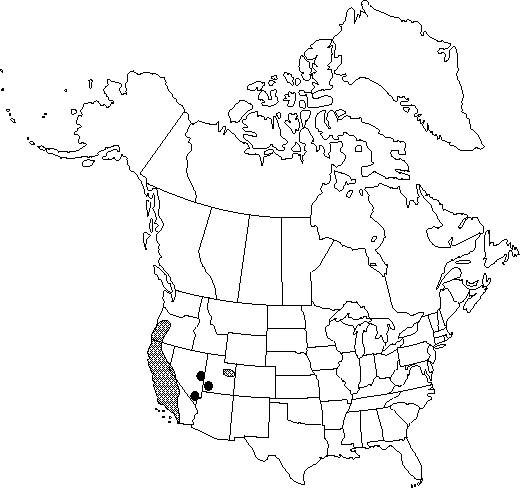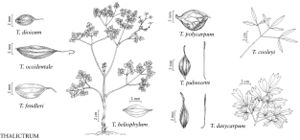Thalictrum polycarpum
Proc. Amer. Acad. Arts 14: 288. 1879.
Roots fibrous. Stems erect, 6-18 (-20) dm, glabrous. Leaves mostly cauline, petiolate. Leaf-blade 3-4×-ternately compound; leaflets orbiculate to obovate, apically 3-cleft or 3-parted, divisions undivided or shallowly 3-lobed, 15-40 mm wide, lobes rounded or somewhat acute, surfaces glabrous or glandular. Inflorescences terminal, panicles, many flowered. Flowers: sepals whitish to purplish, elliptic to ovate or lanceolate, 2-4 (-5) mm; filaments whitish to pinkish, 3-6 mm; anthers (1.4-) 2-4 mm, distinctly apiculate. Achenes 10-15, spreading in globose heads, not reflexed, sessile or nearly so; stipe 0-0.6 mm; body nearly globose to obovoid to obliquely obovate, laterally compressed, somewhat inflated and papery, 4-7 (-8) mm, glabrous to glandular, often with 1 or 2 primary-veins on each side, veins sinuous, branched, anastomosing-reticulate; beak 2-4 mm.
Phenology: Flowering mid-late spring (Apr–Jun).
Habitat: Streamsides and other moist places, forests, and open woodlands
Elevation: 600-3100 m
Distribution

Calif., Nev., Oreg., Utah, Mexico (Baja California)
Discussion
Thalictrum polycarpum is the only species in sect. Heterogamia with anastomosing-reticulate veins on the achene.
The stems and roots of Thalictrum polycarpum are considered poisonous when ingested by humans or cattle; Native Americans used this species medicinally as a wash for headaches, as an applications for sprains, and as a universal charm and panacea (D. E. Moerman 1986).
Selected References
None.
Lower Taxa
"glabrous" is not a number. "glandular" is not a number."dm" is not declared as a valid unit of measurement for this property."dm" is not declared as a valid unit of measurement for this property.
